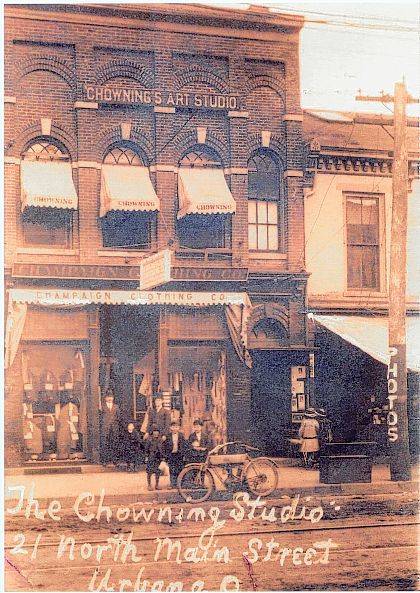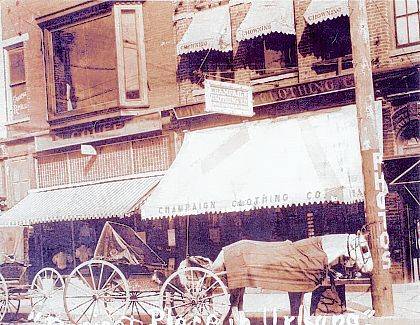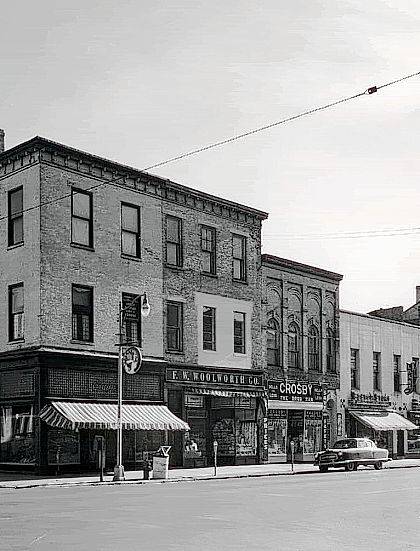


Editor’s note: This is part 3 of a 3-part series previewing the Urban Loft Tour.
Saturday will feature the fourth annual Urban Loft Tour in downtown Urbana from 10 a.m. to 3 p.m.
Below is the second part of a list of locations on the tour. The remainder of sites were profiled in Thursday’s edition.
2017 Urban Loft Tour Locations: Part 2
114 Scioto Street
Amber and Cody Smith and the couple’s two young children are urban pioneers. Their home on the second floor of 114 Scioto Street has been a multi-year labor of love. They took on the challenge of turning the two former apartments on the upper floor into a warm and welcoming three bedroom home. What’s more … they did it while living in the space with very young children! The exterior of the building has also received a new color scheme thanks in part to a Façade Grant from CCPA. The home was featured in the 2015 Tour as a work is progress. This year, tour visitors will be able to see the completion of the Smiths’ vision.
One of the former apartments became the bedroom wing. What small boy wouldn’t enjoy spending time in his own little window seat nook overlooking Scioto Street where he can watch the world go by. Their daughter enjoys a cozy nursery. A spacious master suite with access to a wide covered porch completes the east side of the building. The west side of the renovated space has been completely opened up. It features exposed brick walls and a modern kitchen with a huge central island in a space perfect for entertaining. Unlike most downtown residences the upper floor of 114 Scioto enjoys a deep porch which stretches across the entire back of the structure.
Sanborn maps of Urbana indicate that the building was constructed sometime between 1890 and 1895. At the first part of the twentieth century, the building was known as the Western Mutual Building. Today, we think of insurance companies as huge corporations, often national in scope, with the local insurance profession acting as agents. In the 19th and early 20th century, Urbana had its own locally owned firm, Western Mutual Fire Insurance Company. It was chartered in Urbana on July 28, 1846. By 1920 it had more than 150 agents across Ohio. Earlier, its offices where located in the building at 12 Monument Square which is also on the 2017 Tour.
Other early ground floor occupants included Ross & Brand Insurance and the Urbana Woman’s Exchange. In 1916, one of the buildings two store fronts was the home of Glenn’s Music Store. Glenn’s did large illustrated advertisements in the local newspapers. They stressed that “we are licensed by Mr. Edison to demonstrate and sell his new invention … which re-creates all forms of music with such perfection that the Edison Re-Creation cannot be detected from the original.” Other commercial tenants included Pioneer Rural Electric, Dowds Agricultural Service, The Ohio Fuel Gas Company and R. M. Johnson who sold a variety of automotive products.
During World War II, the building housed the Champaign County War Price and Rationing Board. Consumers and dealers were required to register with the Board and were issued ration books for fuel oil and gasoline. For much of its history, the upper floors of the building seem to have been largely residential with an occasional professional office.
As you enter the building take time to appreciate the elaborate metal hoods which enliven an otherwise subdued front façade. Unlike many downtown buildings, the entry doors and large display windows are original to the structure.
123 North Main Street
Today, Urbana’s commercial and professional community is clustered on the eastern edge of the city making Scioto Street a busy thoroughfare. In the 19th and early 20th century Main Street was the main commercial artery of the city. As we examine the architectural history of the city, we are often better able to document buildings on Main Street and Monument Square. They seemed to hold the interest of the photographer. Then, too, parades of the day often followed Main Street and historically minded photographers sought to document such events. All these factors combine to give us a decade’s long picture of the exterior of 123 North Main Street. It is a particularly photographic building with is decorative brickwork highlighting the graceful interlocking arches of its second floor windows. It is such a pleasing style that the building has a near twin at 119 South Main.
There was a great deal of volatility in Urbana’s business community throughout the 19th century. The editor of the Citizen and Gazette gave a dizzying account of the changes in the 1880s for the Square and four core blocks of the downtown that ran to nearly a full page of failures, illnesses, moves and deaths. It can be difficult to distinguish exact buildings prior to that period because street numbers were changed and directional locations were typical in newspaper references. The first time we can clearly identify 123 North Main Street is in 1882 when it became the home of M. M. Hance Dry Goods. In 1886, the building found a long term tenant when William Harris and John Brennan opened the Champaign County Clothing Company. At a time when newspaper ads tended to be just a line or two of small type, Champaign County Clothing opened with quarter page ads with huge boldface type and a highly aggressive style. In 1906, the name changed to the Charles Scherer Store when the manger bought out the business. Scherer’s remained a force in men’s clothing until its closure in 1949. During the second half of the 20th century, the building would be associated with Justin Crosby’s pharmacy and the catchy logo “Crosby, The Drug Man.” Crosby’s would continue at this location into the 1990s. With the turn of the new century, Tommy Brooks Salon would open. Owners Andrea and Andy Russell have always looked for ways to highlight the building’s historic façade. Over the years they have received advice and assistance from the Urbana preservation community including a recent Commercial Façade Grant from CCPA.
The second floor of 123 North Main is still awaiting renovation. Time has left clues of former occupants. Newspaper advertisements and early photographs remind us that for many years the space was home for the C. H. Chowning photographic studio. For several decades in the twentieth century, the second floor was associated with dentistry. In the 1920s it was home to the Philadelphia Dental Rooms Co. where managing dentists changed fairly frequently. Throughout the 1950s, it was the offices of the young Dr. Charles Bohl who came to Urbana following graduation from the OSU dental school in 1951. Like many medical professionals in downtown Urbana, in 1959 Dr. Bohl would move his offices to the “New Medical Building” near the hospital. However, shadows on the floor still mark the location of the dental chairs where patients could look out on Main St. The rear room also has construction shadows on the floors, walls and ceiling. Take time during your visit to note these reminders of former times and to imagine what might have been there. Above all, however, savor the unique character of the building and visualize what might yet be in these currently underutilized spaces.
NX23 Railcar – 644 Miami Street
The final stop on this year’s Urban Loft Tour isn’t exactly on an upper floor but it does have the bare housekeeping necessities! In its heyday, it was constantly on the move. It’s the Champaign County Preservation Alliance’s NX23 Railcar which is now permanently installed next to the Simon Kenton Trial bike path and the Depot Coffee House, originally Urbana’s Pennsylvania Railroad station, at 644 Miami Street. The car was constructed as a boxcar at the Pennsylvania Railroad’s Altoona shops in 1913. However, during World War II there was a shortage of cabooses. The Pennsylvania Railroad converted 75 “X23” boxcars to cabooses, adding the letter “N” to the X23 designation. The remodeling included two bay windows, and ten round windows. The interior was refitted with a cooking/heating stove, a bunk and table booth, a coal bin and three lockers. The car is now also outfitted with several Urbana-made Johnson “Diamond J” kerosene hanging lamps. During the post-war era, this car was used as a Pennsylvania Railroad maintenance-of-way car on the route from Columbus to Bradford, Ohio. In the 1960s the Railroad sold two cars without trucks (wheel assemblies) to Marion W. Parks, a local building supply dealer, who used them on Miami Street as an office and for storage. In 1999, the Parks family donated the cars to the Champaign County Preservation Alliance. A dedicated group of volunteers began the challenging task of moving and restoring the one car that could be saved. There are only four known examples of NX23 railcars left today. The others are in Pennsylvania, New Jersey and Indiana. Come aboard the CCPA NX23 Railcar and find out what it was like to work and travel across country in this unique car.
Historic photographs: A Window on the Past
Photographs literally give us a window into the past. They are a view of a unique slice of time. They can also be an extremely important resource to anyone involved in historic preservation. Building photos help to document roof lines, decorative embellishments and window configuration. They can be helpful in dating the time frame of major changes to a structure and often provide evidence as to whether or when the building was painted. They even tell us something about the customs of the people who were using the buildings. For example, images of a downtown commercial area often show the use of advertising signs, or window awnings and even public utilities like telephone and electric lines.
It’s very much the luck of the draw as to whether any given structure will have a photographic record. Relatively few photographs find their way into public collections. Professional photographers go out of business and their files are lost. Family members cleaning out attics decide they don’t have the space or interest to save boxes of photos.
Both the Champaign County Historical Society and the Champaign County Library have excellent collections of local history interest. Even with these two fine resources most of the buildings on the year’s Champaign County Urban Loft Tour are not well documented. Perhaps only a single image survives or the building is only visible in a wide-angle view of a street or in a postcard.
This year of the eight buildings on the tour the most documented one from a photographic perspective is 123 N. Main Street. Perhaps its distinctive arched windows caught the eye of photographers. The building also had the good luck to have a photographic studio in its second floor. Main Street was often a parade route so although the primary reason for the photograph was to document the parade, the building was there in the background. 123 North Main was also fortunate to be the home of businesses who stayed in the same location for years and who came to be thought of as local “institutions.” So in the case of 123 North Main Street, we have comparisons over several decades.
As you tour downtown Urbana during the Champaign County Preservation Alliance’s 2017 Urban Loft Tour on Saturday, Nov. 4, take time to look at the exterior facades of the buildings. Think about the history they have witnessed. Celebrate the creative owners who are affirming their belief in the continued usefulness and vitality of these buildings. Dream about the possibilities of adaptive re-use of the buildings whose upper floors are waiting for new life.




